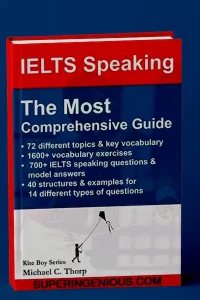IELTS Speaking Most Comprehensive Guide will provide you with 72 different topics and key vocabulary with more than 1600 vocabulary exercises. It also contains more than 700 IELTS Speaking questions and model answers.
IELTS Speaking Most Comprehensive Guide
Use this 3-hour lesson plan for just one topic from the book for intermediate to advanced IELTS speaking classes, and time disappears, and most students pick up a lot of new vocabulary and have a huge amount of well-guided IELTS speaking test practice.
I wrote the book as I couldn’t find one with enough relevant vocabulary, vocabulary reinforcement exercises, practice questions with model answers, and different structures for answering the different types of questions. I was tired of writing so much on the board.
- Play a TED talk video (~5-10 minutes long) related to the topic.
- Back to the board (keyword vocabulary)
The teacher puts the students into 4 teams, who stand in front of the whiteboard with one each team member facing them, seated on a chair – back to the board. The teacher writes a word from the key vocabulary on the board, and the students who are standing have to describe the word to their team member seated, without saying the word or using body language or the root word. If one of the people seated knows the answer, they raise their hand, and their team gets one point if it’s correct. - Pronunciation Practice (keyword vocabulary)
Then, with all the words on the board, the teacher can model the more difficult words, get the students to practice, and ask them questions about themselves related to the words to provide meaningful context and informal practice. - Vocabulary Exercises
Next, project the vocabulary exercises onto a whiteboard and get different students to come up and complete the first and then the second 10-question vocabulary exercises. Afterwards, the teacher can again get them to practice pronouncing any difficult words. - Part 1 Practice Questions
Video project the part 1 practice gap-fill questions onto the whiteboard and get different students to come up and fill in the gaps in the model answers. Then, the students can practice answering them in pairs, following the structures given, but with answers that are true for themselves.Afterwards, the teacher could select different students to stand up and answer the questions to the class and provide feedback. - Speaking – Part 2
Students complete the one-minute preparation for topic in the spaces provided. Before the students do their two-minute speeches in pairs, the teacher could go around the class and ask each student to very briefly tell them what their story (problem) is. - Speaking – Part 3
For the part 3 questions, the teacher can work though the model answers provided and then brainstorm ways of answering the practice questions. Then, the students can practice answering them in pairs, following the structures given.
Afterwards, the teacher could select different students to stand up and answer the questions to the class and provide feedback. - Different Types of Part 1 or 3 Questions
For the different types of part 1 or 3 questions, the teacher could brainstorm ways of answering one type of part 1 or 3 question, and then the students could practice them in pairs.Afterwards, the teacher could select different students to stand up and answer the questions to the class and provide feedback.Note:
It’s really energising for the students to move them around after each speaking exercise, so they can practice with many different partners.


